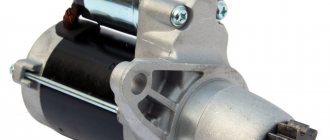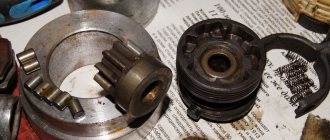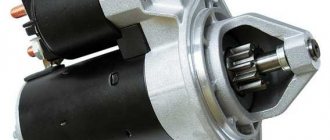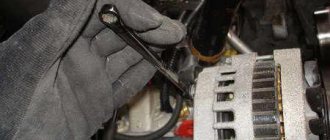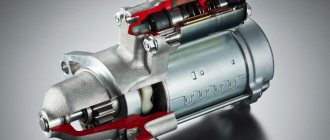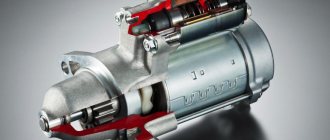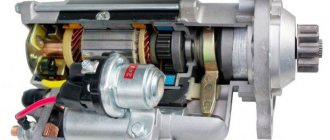Incorrect brush replacement
As a rule, if the starter has not been repaired for a long time and its brushes have not been replaced, the polarity of the supplied voltage can easily be disrupted. In other words, the positive and negative positions in the starter cables have been reversed. The reason is depressurization of the line and mutual contact of wires.
Starter brushes
Another development of events is also likely when the starting device has previously been repaired. The procedure for replacing the brushes this time was carried out incorrectly, the elements were accordingly placed in the wrong sequence. You need to test and determine where the brush with the “plus” polarity is facing. She should look directly opposite the "minus".
To determine the polarity of the brushes, simply attach them to each other. Accordingly, attraction or repulsion will help determine the correct polarity.
Incorrectly installed brushes are usually associated with the starter cover. It is placed incorrectly, which leads to polarity reversal (more on this below).
Clutch fork repair cost
At auto repair shops, specialists can provide you with services for replacing the clutch fork. This procedure will cost from 4,000 to 6,000 rubles. It is not necessary to buy parts separately if you are doing the repairs yourself. The entire clutch kit will cost from 3,000 rubles. The cost of the clutch fork itself reaches about 500 rubles.
Video of replacing a car clutch fork:
Adjusting and replacing the clutch on a Gazelle
Replacing the working or master cylinder of the clutch on a Gazelle, as well as other parts, can prevent car failure. It is important to diagnose and repair the vehicle in a timely manner, and replace the clutch kit and other components as needed. In the future, this will help avoid breakdowns on the highway and accidents.
Clutch diagram for Gazelle
Related Posts
Why, when I close the air, the starter turns, but as soon as I start to take the air off, the starter goes out? The starter is new, the Akum 190 is also new, the tractor is MTZ 82.1, the capital was done last year, the hot pressure is 3.
- Author: Vadim Kutlubaev
- 25 February 15:19
- 22 comments
Guys, this is a problem: I close the air, the starter turns.
As soon as I start to bleed air, the starter goes out. What is the problem I can’t understand? The starter is new, the Akum 190 is also new, the tractor MTZ 82.1, capitalization was done that year, the pressure is on the hot 3. Why do you close the air, the Starter turns, you open it goes out, the new battery is the battery 190 MTZ MTZ 82.1 Major repairs did the Pressure on the hot 3
Breaking
If the manual transmission is noisy, there are reasons for this:
- the bearings performed their functions to the end;
- lack of oil.
The second problem is much easier to solve than the first. Check the amount of oil and “add” it.
We advise you to watch: how to repair a manual transmission on Gezali.
The first option requires replacement of spare parts. This is done either in a service center by specialists (if the car is under warranty, this is a big plus for the owner), or manually (but not by yourself). Only a person who knows the business can disassemble and assemble the checkpoint. This procedure requires knowledge, patience and perseverance.
So, the first thing to do is drain the oil. After this, remove the cardan. Mark the hinge points and the box extension, remove the clamp. Unscrew the cardan mount and remove the shank (move it back and pull it out). The result will be a niche. Next, remove all the necessary parts in the cabin, turn off the speedometer and light elements. After these steps, the box is removed and disconnected.
Gearbox design for Gazelle Next
In order to begin disassembling the gearbox, it needs to be made clean (washed thoroughly). Disassembly is carried out step by step only by a knowledgeable person. At the slightest mistake, the gearbox may not work correctly on the Gazelle Next or, in general, show no signs of life. After disassembling the box into parts, they should also be washed from traces of oil.
The cause of the strange sound is being found. It could be:
- wear of the secondary shaft bearing.
- Bearing play.
- Bearing idling.
Watch the video: how to replace the rear axle gearbox.
Other problems with component parts may also occur. Worn and broken components are replaced with new ones.
Some starters spin clockwise, others counterclockwise. Why is that?
Almost all engines spin clockwise when looking at the engine from the front. Some VOLVO engines spin in the other direction - counterclockwise. In this case, it is logical to assume that the starters should also rotate in one direction or the other. This is true.
But, for most engines that spin clockwise, the starters can also spin in different directions. It turns out that this depends on the layout of the unit. That is, it depends on how the starter is positioned relative to the engine.
The starter relative to the engine can stand like this, in this case the starter rotation should be clockwise. It doesn't matter which side of the engine it is on. For example, 402 and 406 engine.
Or it may stand like this, in which case the starter rotation should be counterclockwise.
Should I charge the hydraulic chain tensioner?
Should I charge the hydraulic chain tensioner?
Unread message ZVR » 09 Apr 2013, 23:28
I bought a Volga and I don’t regret it, I don’t regret anyone.
IT'S A PINK, BABY!
Re: Should I charge the hydraulic chain tensioner?
Re: Should I charge the hydraulic chain tensioner?
Unread message GAZ » April 10, 2013, 10:25
Re: Should I charge the hydraulic chain tensioner?
Unread message ZVR » Apr 10, 2013, 10:32 am
I bought a Volga and I don’t regret it, I don’t regret anyone.
IT'S A PINK, BABY!
Re: Should I charge the hydraulic chain tensioner?
GAS , I also recharged at one time. A little hemorrhagic, but possible. However, I had three cases where chains with such tensioners were thrown, and they definitely worked (mainly the upper ones), but something happened during operation, and I refused to recharge. In the end, 300 rubles. - not that much money to invest in such a rather important mechanism - a timing drive.
ZVR , there are rechargeable tensioners. But there is one nuance - you need to put the tensioner at the top a little longer. There were such people at one time, but now there are practically none left.
HOW TO CONVERT THE MTZ STARTER TO REVERSE ROTATION
Hi all. Guys, tell me how to change the direction of rotation of the starter? I really need it.
- haughty1923 June 15, 2015 00:01
- scratch198503 June 15, 2015 00:09
Swap the grids
- foliage199010 June 15, 2015 00:44
haughty1923, what do you mean by polarity, like in places plus and minus? So the minus is looped with the starter housing. If I remember the polarity, there will be a short circuit.
- brontosaurus June 15, 2015 02:17
Change the polarity on the starter relay
- crewmen197905 June 15, 2015 04:48
You guys are fucking experts here)))
- 38shady7 June 15, 2015 05:59
starter is different from starter. Is the inductor permanent magnet or with a winding? If with a winding, then turn out either the brushes or the inductor (relative to each other, that is, change the polarity either here or there) if with permanent ones, just change the polarity of the brushes.
- foliage199010 June 15, 2015 08:19
38shady7, the guy has a three-wheeled scooter, some kind of old Honda. So, there is a starter just like on a regular scooter, but the rotation of the starter itself is the opposite. There is no point in changing the polarity of the starter from outside because the minus is connected to the starter housing. I think it’s possible to disconnect the negative wire from the housing inside the starter and bring out the insulated wire and apply a plus to it, and a minus to the plus.
- foliage199010 June 15, 2015 08:21
brontosaurus, but it’s okay that the starter housing is looped with a minus and if you change the polarity on the relay, a short circuit will occur.
- foliage199010 June 15, 2015 09:05
3middleton, on permanent basis. Thanks for the answer)
- foliage199010 June 15, 2015 09:09
3middleton, why doesn’t the rotation change when the starter housing is turned 180 degrees? After all, the polarity of the magnets must change? I know about the brushes, but will it be possible to transfer it there if the wiring is short and there is very little space. In general, I’ll watch it and report back))
foliage199010, when turned 180 degrees, the polarity of the magnets does not change))) the magnetic field remains in one direction, for that matter, you need to turn the magnets over, but this is impossible due to their shape)))
- cachalot1696 June 15, 2015 12:57
cachalot1696, what is impossible?!
cachalot1696, the most primitive permanent magnet DC machine. you can start the engine back in a children's car using the remote control)))) I understand that if there was a starter with a winding in the inductor, then it would be necessary to disassemble it, figure out what kind of excitation on this engine (series, parallel or (there is no such thing on starters) ) independent)), unsolder the connections, turn the armature circuit or excitation circuit to reverse polarity (BUT ONLY EITHER OR THAT), solder it into a bunch and enjoy the reverse of the DC machine.
- cachalot1696 June 15, 2015 14:35
3middleton, on machines there is a double winding on the rotor and on starters there is a single directional winding
- foliage199010 June 15, 2015 15:13
3middleton, just trust the Internet) but I found in Yandex that it is enough to turn the case over
- foliage199010 June 15, 2015 15:16
cachalot1696, it is enough to change the polarity at the input and the starter rotates in the other direction with a bang, but since the minus is connected to the starter housing, you must either extend the wires inside to transfer the brushes, or disconnect the minus wire from the housing and bring it out independently in the same way and plus. In general, I'll figure it out. THANK YOU ALL FOR THE ADVICE))
cachalot1696, what double?! what single directional?! Even though I don’t remember this method of laying the winding from the course on electrical machines.
- foliage199010 June 15, 2015 19:00
3middleton, he probably meant that two brushes connect one winding ring along the commutator, something like this)
- enumerable June 15, 2015 19:30
Turn the body 360 and everything will be fine
- foliage199010 June 15, 2015 21:04
enumerable, so it will be in reverse place))))))
- cachalot1696 June 16, 2015 09:35
3middleton, bad at studying?
cachalot1696, how can I tell you))) according to those. excellent in the humanities. It’s better not to ask))) So you want to say that reversing the starter is not possible?! Today I’ll go for disassembly, I just need a starter for the winch, naturally I’ll do the reverse, so we’ll test your theory)))
- cachalot1696 June 16, 2015 10:36
You need to install an impeller on the starter
- foliage199010 June 16, 2015 10:42
3middleton, after all, I was right!) You twist the housing 180° and the starter changes the direction of rotation.))) I mean that the polarity changes when the magnets are turned. I knew this, but in practice it turned out that I was checking it in the garage without lighting and could not notice that it was changing rotation) today I turned on the light and felt with my finger and it changes directions as I thought) Only I was confused what rotation it needed) ) Today I’ll go to him and clarify) On my Chinese fifty-kopeck car the starter spins counterclockwise, but when I took the starter from him, it spun clockwise. I don’t know on which side of the crankshaft the starter is located, because this plays a very important role) Things like that)
cachalot1696, I will take the starter with a gearbox,
And of course I’ll do the cooling.
foliage199010, I thought I would have to turn over the magnets themselves)))
- hyper9515 June 20, 2015 11:23
damn I just need a starter like this
- foliage199010 June 20, 2015 13:59
hyper9515, so buy it) just don’t buy “made in China”, otherwise the brushes wear out very quickly. Better take the Taiwanese one.
PLEASE TELL ME HOW TO CONVERT THE MTZ STARTER TO REVERSE ROTATION
What's the secret? Why go in the opposite direction?
Anyone who, instead of one ear or one stalk of grass, manages to grow two in the same field, will render a greater service to humanity and his homeland than all politicians taken together. (Jonathan Swift)
YOU NEED TO BRING ONE IDEA INTO LIFE, BUT TO DO THIS YOU NEED TO CHANGE THE STARTER
what if it's not a secret? Gearbox?
The mass and plus parts should probably be swapped.
People are trying to give you some other solution to your problem, and you are playing the Young Guard.
YES NO WAS AWAY FOR A BRIEF OTHER OPTION IF ONLY SIMILAR TO ASSISTANCE BUT REVERSE ROTATION ANOTHER SOME STARTER
It is useless to change the mass and plus; the rotation will remain the same. You need to swap the tires that are connected to the positive brushes (isolated from the body).
If the polarities are reversed, there will be a short circuit. How to solve the issue with the bendix and the retractor?
clone7719 will this definitely help or is this just a guess.
VVKKTOR take a 12 volt electric motor with electromagnetic excitation for the experiment (it won’t work with permanent magnets - everything is clear there), and swap the leads of the excitation winding. there will be reverse rotation. I haven’t tried it with a starter. but an electric motor is also an electric motor in Africa.
Hello! Since we're on the topic of changing the rotation of the starter armature, I'll tell you about my experience in this matter. I had a Magneton starter, 24V, the armature and stator burned out, I replaced them with new ones. But this winter everything burned out again, it can’t stand long starts, I didn’t bother to repair it anymore and spent almost as much on spare parts as it costs.
In general, I decided to convert it to a 12-volt starter for MTZ82. And I decided to cross a magneton with a Zhiguli starter, small and without a gearbox, I don’t know what it’s called. By turning and welding I completed the stator and the armature for the magneton housing and in general everything according to the geometry of the gearbox spins and rotates.
The time has come for a test, I connected it to the battery and saw that the bendix rotates to the right and should turn to the left. in the magneton, the gearbox is a single reduction gear and has a rotation change, and initially the rotation of the armature on the magneton is right-handed. In general, I decided to change the rotation. I changed the connection from the battery, changed the poles and nothing happened.
started by changing the power points of mass and plus. I changed the brush housings and insulated them, but nothing happened. In the Zhiguli winding there are three serie coils and one is a joke coil. I bought new coils and made two coils on magnetone, it turned out four, two pairs, and there is a chain like this, plus - brush - coil 1 - coil 2 - negative brush.
If you want to use it as a starter to start the engine, then it WILL NOT work, but if just as an engine, then you can do it.
just like an engine
Rotate the stator or brushes 90 degrees, although you will have to tinker with the terminals.
Tags: recharging hydraulic tensioner
Comments 24
I had a tensioner of this design unwind in the engine, twice in a row. As a result, the chain weakens, the engine roars like a diesel and the oil pressure warning light is on. Of course, it recharges great, but I installed it without spinning and now everything is fine
everywhere it is written how to do it... even after 3 hours without literature I charged it. Oh you
car-exotic.com/gaz-cars/gaz-31105-engine-13.html
By the way, about the new tensioners. I bought myself something that looked like a rocket (cylindrical in shape without protrusions at the back). So it turns out there is a cork type gasket inside it, located under the spring. the spring breaks this gasket into pieces, they are picked up by the oil flow and clog the grooves of the hydraulic tappets. so now I take it apart and check it before installing it - if it eats, I throw it away.
but it shoots when you insert it into the well, close it with the lid that has two bolts and there is a plug in the center, unscrew it and press the tensioner with a screwdriver! when pressed, the piston will move slightly back and the stopper will take its position on the piston and thus the piston is already free and flies out of the cylinder!
+100500! Only I did it without a mandrel, I just used a flat screwdriver to unscrew this very ring in a circle with the piston inserted. and the main thing is not to press on the end of the piston - otherwise it will discharge and you will have to do everything all over again
yes this is also an option!
but it shoots when you insert it into the well, close it with the lid that has two bolts and there is a plug in the center, unscrew it and press the tensioner with a screwdriver! when pressed, the piston will move slightly back and the stopper will take its position on the piston and thus the piston is already free and flies out of the cylinder!
I also did it with a screwdriver. But the infection doesn’t hold on and shoots out. I also tried to open the ring. It turns out that you need to press down on the tensioner so that the piston presses in? I thought there must be something sticking out of the lid.
there you can even press the bolt in the lid so that it discharges
I also did it with a screwdriver. But the infection doesn’t hold on and shoots out. I also tried to open the ring. It turns out that you need to press down on the tensioner so that the piston presses in? I thought there must be something sticking out of the lid.
and you shouldn’t really unclench the stopper, otherwise it won’t discharge later! decompress only under the influence of its springy properties
I also did it with a screwdriver. But the infection doesn’t hold on and shoots out. I also tried to open the ring. It turns out that you need to press down on the tensioner so that the piston presses in? I thought there must be something sticking out of the lid.
you need to combine the groove on the body with the groove on the piston, where the springy ring is currently located. At the same time, try to make the piston come out a little higher - take a flat screwdriver, place the ring lock on the right or left, press on the lower part of the ring with a screwdriver, it goes to thicken the cylinder and in the groove on the body and while it is held due to friction, you recess the upper part in the same way, as soon as this action is completed, you push the piston up even more until it stops. And if you have a second screwdriver and an assistant, there are no more problems.
Gazelle, gas forum, gas club, gazelle repair, gazelle car
Is it possible to mix it up and install a left-hand starter instead of a right-hand one?
All starters are different at the point of connection and there is no such thing that the starters are exactly the same, only one is left and the other is right, so erroneous installation is impossible.
A similar starter, with a different direction of rotation, will not work not only because it spins in the opposite direction, but simply because it has a different connection point. A starter can only be installed that is designed specifically for this engine.
If you just hold the starter in your hands, it is not clear in which direction it will rotate. If this is important, then you can twist the bendix with your finger. Where the bendix spins easily is the direction of rotation of the starter.
Starters are made by different manufacturers; in appearance, starters, for example BOSCH and VALEO, are noticeably different, they consist of completely different parts, but if they are intended for the same engine, then their connecting places are exactly the same, and they naturally rotate in one and the same the same side.
Operating principle of the clutch system
To transmit torque to the driving wheels of the vehicle from the engine crankshaft, a box is provided, because smooth transmission of torque from the motor to the wheels is unprofitable. The car will not be able to move without a clutch, and the operation of the power unit itself will be ineffective.
For comfortable operation of the power plant, the torque removed from the crankshaft must be changed in advance in the gearbox (gearbox). After which it moves to the driven axle. Since changing gears forces the gearbox gears to spin, which hit each other with force, it can be difficult to change gears. If the box is always connected to the unit, in order to completely stop the vehicle, it will be necessary to stop the motor.
Clutch operation in a Gazelle car
To solve these problems, the car is equipped with a clutch, which is a special box assembly. It promotes temporary separation of the engine and gearbox, which leads to an interruption of torque. By pressing the clutch pedal, you can change gears or stop the car. The clutch allows the car to move off smoothly and accelerate.
Read:
The principle of its operation is similar for any brand of car. It eliminates the possibility of rapid wear of components and parts that connect the power plant and the gearbox.
The clutch pressure plate, attached to the housing, presses the driven disc against the flywheel. The disk hub attached to the input shaft must be able to move freely along it. The hub body is equipped with damper springs, which act as vibration dampers and ensure smooth operation.
To make the required force when pressing, a spring with petals is provided, which are exposed to the release bearing. It is a connecting link between the drive and the clutch, onto which the fork with the lever is attached. Another lever or cable is attached to its end, leading to the clutch pedal.
Replacing the ZMZ-402 clutch fork on the Volga
Replaced early in the afternoon on a weekend
I'm
using the clutch fork
.
How to replace the clutch fork without removing the gearbox.
how to replace clutch fork
VAZ-2101-2107 cars without removing the gearbox. VKontakte groups for repairs...
Starters: how they work and how to repair them
The starter is the most “feminine” part of the car! After all, it is believed that it was the electric engine start that allowed the fair sex to seriously get behind the wheel, because before its invention, the car was started with a hand crank, which not every man could do... At the same time, as a mechanism, the starter is not femininely reliable and predictable, thanks to unfeminine rudeness and simplicity of design, and therefore rarely causes problems for the owner of a new car during 3-5 years of its service.
And initially the car was born without a starter - the engines were started with a crank, and this was considered the norm. Actually, the cars of the dawn of motorization had enough other, more pressing problems, against the background of which turning the handle before the trip was not the most significant. However, the difficult and unsafe starting of the engine by hand was still an obvious bottleneck of the first self-running carts, and in 1911 the American mechanical engineer Charles Kettering proposed the design of an electric starter. And already in 1912, the first car powered by Kettering’s invention, the Cadillac Model 30, was produced.
However, despite this, a technical revolution did not occur - which can be traced at least by the famous Ford T, which, produced in millions of copies, was wound up with a handle until 1919... Actually, the reason was to a large extent that Charles Kettering, crowned the inventor of the starter, proposed to Cadillac a completely different design than is used everywhere these days!
GAZ gearbox - lever rattling ⇐ General technical issues
Post by Shuriken » 24 Feb 2011, 00:31
Post by Kex » 24 Feb 2011, 20:57
Post by vn800 » Feb 24, 2011, 10:57 pm
Post by V.filaxtov » Mar 27, 2011, 11:17 pm
Post by Volga Vasily » March 31, 2011, 04:13
Post by Shuriken » 01 Apr 2011, 10:28
Post by SENKA » April 6, 2011, 2:36 pm
Post by V.filaxtov » Apr 10, 2011, 11:44 am
Selling gearbox cover, gearshift lever for RAF. I bought it for my car. The cover is in excellent condition, has not seen the hands of the master. I will answer all your questions via PM or +79787662214 (Viber. WhatsApp) - Evgeniy.
- Club questions
- ↳ Club life
- ↳ Retro events
- ↳ Retro fest in Sokolniki
- ↳ Oldtimer gallery of Ilya Sorokin
- ↳ Autostrada-Tula
- ↳ Autostrada-Kaluga
- ↳ Motor rallies
- ↳ Other retro events in Moscow
- ↳ Retro events in Podolsk
- ↳ Retro events in St. Petersburg
- ↳ Other retro events in the regions
- ↳ Retro events in Ukraine
- ↳ Retro events in Belarus
- ↳ Retro events in other countries
- ↳ Club meetings
- ↳ Friendly clubs and partners
- ↳LATVIJA
- ↳ Royal Retro Club
- ↳ Podolsk retro club
- ↳ Tver retro club
- ↳Microbe
- ↳ Club paraphernalia
- ↳Foreign Languages Forum
- ↳ Our cars
- ↳ ErAZ
- ↳RAF
- ↳Barkas
- ↳Bedford
- ↳Ford Transit
- ↳Nysa
- ↳Skoda
- ↳ VW T2
- ↳ VW T3
- ↳Zuk
- ↳ Other projects of club members
- Model range of cars
- ↳RAF
- ↳ RAF. Advertisements by section
- ↳ History of the Riga Bus Factory
- ↳ RAF. Our cars
- ↳ RAF 2203-22038
- ↳ RAF 2203-22038. Engine
- ↳ RAF 2203-22038. Engine. Supply system
- ↳ RAF 2203-22038. Engine. Cooling system
- ↳ RAF 2203-22038. Engine. Lubrication system
- ↳ RAF 2203-22038. Transmission
- ↳ RAF 2203-22038. Transmission. Clutch
- ↳ RAF 2203-22038. Transmission. Gearbox and speedometer drive
- ↳ RAF 2203-22038. Transmission. Cardan transmission
- ↳ RAF 2203-22038. Transmission. Rear axle
- ↳ RAF 2203-22038. Steering
- ↳ RAF 2203-22038. Chassis
- ↳ RAF 2203-22038. Chassis. Front suspension
- ↳ RAF 2203-22038. Chassis. Rear suspension
- ↳ RAF 2203-22038. Chassis. Wheels
- ↳ RAF Encyclopedia. Wheels
- ↳ RAF 2203-22038. Brake system
- ↳ RAF 2203-22038. Electrical equipment
- ↳ RAF 2203-22038. Electrical equipment. Generator, starter, battery
- ↳ RAF 2203-22038. Electrical equipment. External lighting devices
- ↳ RAF 2203-22038. Electrical equipment. Instrument panel, wiring, interior electrical equipment
- ↳ RAF 2203-22038. Electrical equipment. Glass cleaners and washer
- ↳ RAF 2203-22038. Electrical equipment. Ignition system
- ↳ RAF 2203-22038. Body and interior
- ↳ RAF 2203-22038. Body and interior. Body repair and painting
- ↳ RAF 2203-22038. Body and interior. Bumpers and tow bar
- ↳ RAF 2203-22038. Body and interior. Glass, window lifters, seals
- ↳ RAF 2203-22038. Body and interior. Doors, locks, mirrors
- ↳ RAF 2203-22038. Body and interior. Interior details
- ↳ RAF 2203-22038. Spare parts and cars
- ↳ RAF. Spare parts and cars. Manufacturing of original parts
- ↳ RAF. Cars. I will buy
- ↳ RAF. Cars. Selling
- ↳ RAF. Spare parts. I will buy
- ↳ RAF. Spare parts. Selling
- ↳ RAF 2203-22038. Literature
- ↳ RAF-977
- ↳ RAF-"Chaika" (13С, 3920)
- ↳ Souvenirs, toys, posters RAF
- ↳ ErAZ
- ↳ History of the Yerevan Automobile Plant
- ↳ ErAZ. Our cars
- ↳ ErAZ. Engine
- ↳ ErAZ. Transmission
- ↳ ErAZ. Steering
- ↳ ErAZ. Chassis
- ↳ ErAZ. Brake system
- ↳ ErAZ. Electrical equipment
- ↳ ErAZ. Body, interior
- ↳ ErAZ. Cars and spare parts
- ↳ Zuk, Nysa, Tarpan, FSO m-20 Warszawa, Syrena, etc.
- ↳ News from the Polish branch
- ↳ History of the Polish automobile industry
- ↳ Poles: Zuk, Nysa and more!
- ↳ Gallery
- ↳ Our cars
- ↳Zuk
- ↳Nysa
- ↳ Garage Zuk, Nysa
- ↳ Zuk, Nysa. Engine
- ↳ Zuk, Nysa. Transmission
- ↳ Zuk, Nysa. Steering
- ↳ Zuk, Nysa. Chassis
- ↳ Zuk, Nysa. Brake system
- ↳ Electrical equipment Zuk
- ↳ Electrical equipment Nysa
- ↳ Body, frame, interior Zuk
- ↳ Body, frame, interior Nysa
- ↳ Zuk, Nysa. Wheels
- ↳ Zuk. Supply system
- ↳ Zuk. Supply, cooling, exhaust systems
- ↳ Literature of the Polish automobile industry
- ↳ Spare parts and cars
- ↳Zuk
- ↳Nysa
- ↳ Skoda, Avia
- ↳Skoda
- ↳ Skoda. Our cars
- ↳ Skoda. Device and repair
- ↳Avia
- ↳Barkas
- ↳Barkas. Our cars
- ↳Barkas. Story
- ↳Barkas. Engine
- ↳Barkas. Power and exhaust system
- ↳Barkas. Cooling system
- ↳Barkas. Transmission
- ↳Barkas. Suspension
- ↳Barkas. Control and braking system
- ↳Barkas. Electrical equipment
- ↳Barkas. Frame, interior, body
- ↳Barkas. Wheels, tires, hubcaps
- ↳Barkas. Tool
- ↳Barkas. Schemes, literature
- ↳Barkas. Tuning and various upgrades
- ↳Barkas. Tuning and various upgrades. Engine
- ↳Barkas. Tuning and various upgrades. Transmission
- ↳Barkas. Tuning and various upgrades. Cooling system
- ↳Barkas. Tuning and various upgrades. Suspension
- ↳Barkas. Tuning and various upgrades. Control and braking system
- ↳Barkas. Tuning and various upgrades. Body, frame, interior
- ↳Barkas. Tuning and various upgrades. Electrical equipment
- ↳Barkas. Consultation from Kex
- ↳Barkas. Cars and spare parts
- ↳ Other equipment of the GDR
- ↳IZh cars
- ↳ History of the Izhevsk Automobile Plant
- ↳ IZH. Our cars
- ↳ Classic cars IZH
- ↳ Family "Oda"
- ↳ IZH. Spare parts and cars. Buying and selling
- ↳ VW
- ↳ History of Volkswagen minibuses
- ↳LT
- ↳T1
- ↳T2
- ↳ T2. Our cars
- ↳ T3
- ↳ T3. Our cars
- ↳Bedford
- ↳ Bedford. Our cars
- ↳ Bedford. Story
- ↳ Bedford. Engine
- ↳ Bedford. Transmission
- ↳ Bedford. Steering
- ↳ Bedford. Chassis
- ↳ Bedford. Brake system
- ↳ Bedford. Electrical equipment
- ↳ Bedford. Body, interior
- ↳ Bedford. Cars and spare parts
- ↳Ford
- ↳Aerostar
- ↳ Transit
- ↳ Transit. Our cars
- ↳ Transit. Spare parts and cars
- ↳ Fiat
- ↳LDV
- Buses
- ↳ ASCh-03 “Chernigov”
- ↳ ZIL
- ↳ “Youth”
- ↳ Kuban
- ↳ LAZ
- ↳ LiAZ
- ↳ PAZ
- ↳ CHAZ
- ↳Ikarus
- Other minibuses and buses
- ↳ English
- ↳ French
- ↳Japanese
- ↳ Americans
- ↳ Other models
- Shopping Row
- ↳ Retro cars. Buying, selling
- ↳ Spare parts and accessories. Buying, selling
- ↳ Tires and wheels. Buying, selling
- ↳ Services. Demand Offer
- Communication
- ↳ General technical issues
- ↳ Loader cranes
- ↳ Legal issues
- ↳ Gazebo
- Forum of retro buses and minibuses
- Time zone: UTC+03:00
- Delete cookies
Powered by phpBB® Forum Software © phpBB Limited Russian phpBB Support
Time: 0.093s | Peak Memory Usage: 3.45 MB | GZIP: On
Wind generator based on starter
The idea of making a wind generator appeared when the early autumn nights arrived. I decided to try using wind energy for household needs. Let the wind charge the battery, which will illuminate the garden toilet standing at the edge of the site.
It’s expensive to run a network cable to this object, you’re tired of changing batteries in a Chinese lantern, and then the free, periodically renewable energy is wasted. Since bright lighting is not required at this facility, reading books and the press is not planned, low powers are sufficient to solve this problem.
In practice, this is a generator with a power of several watts and a small-capacity battery. During the day, the battery stores wind energy, and at night releases it as needed. For such wind generators, there is practically no point in performing complex calculations and making special blades.
For use as a low-power wind generator, you can use a ready-made stepper motor. For maximum efficiency, if there is a choice, it is advisable to use a motor with the minimum possible sticking of the shaft (they have such an unpleasant effect) and with the largest possible number of steps per revolution.
It is possible to convert the electric motor into a generator. Various modification options are described on the Internet.
In our case, we chose the option of remaking the used starter 923.3708 from the legendary Oka.
The use of this starter is due to the following factors: • small dimensions and weight of the starter; • the starter is excited by permanent magnets; • ease of modification in the absence of investments for the manufacture of a generator.
The process of converting a starter into a generator
1. Disassemble the starter: Disconnect the power wire and remove the parts of the traction relay. We release and remove the body and shaft of the overrunning clutch and the built-in planetary gearbox.
2. Carefully remove the cover of the brush assembly. At the same time, we monitor the safety of the support ball in the cover bearing. We disassemble and remove the brush assembly. We remove the rotor. Three nodes remain for further use.
3. Using wire cutters and pliers, remove the old starter rotor winding. Mechanically remove the rotor manifold. We clean the shaft and grooves on the rotor plates from any remaining varnish. In the photo, to the right of the new rotor, are the remains of the old winding.
4. We perform mechanical processing of the rotora. Using a lathe or manually, remove the splines for connection to the planetary gearbox and obtain the landing diameter for the second plain bearing.b. Between the set of rotor plates and the treated area, half the diameter, we drill a radial hole with a diameter of 4 mm.
The hardness of the shaft is insignificant and can be processed with high-speed tools.c. On a lathe or manually with a drill, from the side of the treated area, drill an axial hole with a diameter of 4 mm until it coincides with the radial one. We get a hole for the output of the rotor winding. This output circuit eliminates the need for sliding contacts for current collection and increases the reliability of the generator. For greater clarity, the location of the holes and the winding output are shown on the finished rotor.
5. We wind the coil windings into the slots of the rotor until they are filled. The arrangement of six permanent magnets in the stator with alternating poles determined the arrangement of the winding coils.
The width of each coil (number of slots 5) was determined by the distance between adjacent magnets. The turns of each coil, located oppositely in adjacent slots, when the rotor rotates, simultaneously cross the magnetic field of two magnets with different poles. In this case, the induction current in the coil adds up.
To avoid damage to the wire insulation during winding and operation, MGTF stranded wire with a core diameter of 0.30 mm is used. It is possible to use another insulated wire.
6. Due to the absence of a second bearing for the rotor in the used part of the starter (one is located in the cover of the brush assembly, and the second remained in the removed planetary gearbox), we will make a new bronze plain bearing. The outer seat diameter of the bearing is determined by the diameter of the hole in the housing partition (photo below), and the inner diameter of the bearing and the length of the outer steps is determined by the actual diameter and length of the machined section of the rotor shaft (item 4a).
7. We install the manufactured bearing into the housing, and the saved ball at the bottom of the bearing in the cover.
8. We install the machined section of the rotor into the manufactured bearing and assemble the rotor with the housing. Before assembly, lubricate all rubbing parts.
9. Install the brush assembly cover, aligning the second rotor shaft support with the cover bearing and support ball. We align the holes of the body and cover, install the mounting studs from the kit.
10. Assembling the generator. We use the free end of the rotor shaft (with the winding output) to install and secure the generator. We will install a rotor-type wind wheel on the free part of the studs (above the cover).
11. To protect the inside of the generator from dust and moisture, close all free openings with hot-melt adhesive. For testing, I additionally sealed the joints with electrical tape.
12. We make a support for installing the generator on the site.
13. We measure the output data of the generator at medium speeds (rotation by hand). The generator provides a voltage of 1...5 V and a current of 0.2...1.1 A.
14. To test a wind generator, a rotor-type turbine was manufactured.
Advantages of a rotary wind turbine:• In gusty winds, rotary windmills have greater stability in operation than screw ones.• Silence and operation regardless of where the wind blows.• The shaft rotates more stably, without sudden changes in speed.• lightness of design; • ease of manufacture and installation.
ZMZ-406. “Charging” hydraulic tensioners
We bring the jaws of the vice together, leaving a gap of 19 mm between them.
Do not squeeze the tensioner body in a vice. When disassembling two hydraulic tensioners at once, do not confuse their plunger pairs, as they are selected with a certain clearance.
Install the tensioner body in a vice, like in a wrench, using a screwdriver with a wide blade.
Remove the spring from the housing.
We wash all parts in gasoline or kerosene, blow with compressed air and lubricate with engine oil.
From a steel sheet 0.8–1.0 mm thick, cut out a strip (10–15 mm wide and 25 mm long). Using round-nose pliers or a mandrel, bend it into a ring with a diameter similar to that of a plunger.
We install the plunger into the body. If necessary, use a thin screwdriver to adjust the locking ring.
Use a screwdriver to press the bottom, pushing the plunger in until it stops.
Use a screwdriver to press the bottom, pushing the plunger in until it stops.
Using a manufactured mandrel, we fix the retaining ring in the hydraulic tensioner housing.
We install a spring in the plunger, and the body itself in a vice.
Overcoming the resistance of the spring, we wrap the valve into the hydraulic tensioner housing.
Use a screwdriver to tighten the valve, holding the body in a vice (as during disassembly).
For a properly “charged” tensioner, the plunger should be held in the body.
ATTENTION To prevent the hydraulic tensioner from being discharged, do not press on the protruding end of the plunger, and after installing the hydraulic tensioner in the channel of the cylinder head, do not press on the tensioner itself.
Source
